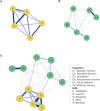Network Analysis of Key Instrumental Activities of Daily Living and Cognitive Domains for Targeted Intervention in US Older Adults Without Dementia: Cross-Sectional Study
- PMID: 40106829
- PMCID: PMC11941277
- DOI: 10.2196/67632
Network Analysis of Key Instrumental Activities of Daily Living and Cognitive Domains for Targeted Intervention in US Older Adults Without Dementia: Cross-Sectional Study
Abstract
Background: Cognitive impairment in older adults reduces independence and raises health care costs but can be mitigated through stimulating activities. Based on network theory, intricate relationships within and between clusters of instrumental activities of daily living (IADLs) and cognitive domains suggest the existence of central IADLs and cognitive domains, as well as bridge IADLs. Modifying these can significantly enhance daily living activities and cognitive functions holistically.
Objective: This study aims to identify central IADLs (key activities within the IADL network), central cognitive domains (key domains within the cognitive network), and bridge IADLs (linking IADL and cognitive networks). These insights will inform targeted interventions to effectively improve IADL and cognitive well-being in older adults.
Methods: A cross-sectional analysis of adults aged 65 years and older in the United States focused on 5 IADLs and 6 cognitive domains from the National Health and Aging Trends Study (NHATS). Network analysis identified central and bridge variables. Nonparametric and case-dropping bootstrap methods checked network stability. Network comparison tests assessed sex differences with Benjamini-Hochberg adjustments.
Results: Of the 2239 participants, 56.4% were female (n=976). We computed and tested 3 networks: IADL, cognition, and bridge-with correlation stability coefficients of 0.67, 0.75, and 0.44, respectively (all>0.25). Meal preparation was identified as the central IADL, with a centrality index of 3.87, which was significantly higher than that of other IADLs (all P<.05). Visual attention emerged as the central cognition domain, with a centrality index of 0.86, which was significantly higher than that of other cognition domains (all P<.05). Shopping was determined to be the bridge IADL, with a centrality index of 0.41, which was significantly higher than that of other IADLs (all P<.05). Notably, gender differences emerged in the IADL network, with stronger associations between laundry and meal preparation in females (1.69 vs males: 0.74; P=.001) and higher centrality in meal preparation among females (difference=1.99; P=.007).
Conclusions: While broad enhancements in all IADL and cognitive domains are beneficial, targeting meal preparation, visual attention, and shopping may leverage their within-network influence to yield a more pronounced improvement in holistic IADL, holistic cognition, and holistic cognition function through IADL interventions among older adults. Notably, meal preparation interventions may be less effective in males, requiring tailored approaches.
Keywords: network comparison; IADL; bridge variables; central variables; cognition function; cognitive domain; cognitive impairment; cognitive network; daily living activity; elder; elderly; holistic cognition; holistic cognition function; instrumental activities of daily living; intervention targets; network analysis; non-demented; older adults; stimulating activity.
©Jiaying Li, Rendong He, Erh-Chi Hsu, Junxin Li. Originally published in JMIR Aging (https://aging.jmir.org).
Conflict of interest statement
Figures



Similar articles
-
Latent cognitive profiles and their associations with instrumental activities of daily living among older adults without dementia: A United States national cross-sectional study.J Prev Alzheimers Dis. 2025 Jun;12(6):100162. doi: 10.1016/j.tjpad.2025.100162. Epub 2025 Apr 9. J Prev Alzheimers Dis. 2025. PMID: 40204581
-
Occupational therapy for cognitive impairment in stroke patients.Cochrane Database Syst Rev. 2022 Mar 29;3(3):CD006430. doi: 10.1002/14651858.CD006430.pub3. Cochrane Database Syst Rev. 2022. PMID: 35349186 Free PMC article.
-
Digital Endpoints for Assessing Instrumental Activities of Daily Living in Mild Cognitive Impairment: Systematic Review.J Med Internet Res. 2023 Jul 25;25:e45658. doi: 10.2196/45658. J Med Internet Res. 2023. PMID: 37490331 Free PMC article.
-
Virtual reality applications based on instrumental activities of daily living (iADLs) for cognitive intervention in older adults: a systematic review.J Neuroeng Rehabil. 2023 Dec 19;20(1):168. doi: 10.1186/s12984-023-01292-8. J Neuroeng Rehabil. 2023. PMID: 38110970 Free PMC article.
-
Relationship Between Visual Functions and Independence in ADLs and IADLs Among Community-Dwelling Older Adults.Am J Occup Ther. 2025 Jul 1;79(4):7904205030. doi: 10.5014/ajot.2025.051016. Am J Occup Ther. 2025. PMID: 40423652 Free PMC article.
Cited by
-
IADL for identifying cognitive impairment in Chinese older adults: insights from cross-lagged panel network analysis.BMC Geriatr. 2025 May 22;25(1):364. doi: 10.1186/s12877-025-06017-1. BMC Geriatr. 2025. PMID: 40405097 Free PMC article.
References
MeSH terms
Grants and funding
LinkOut - more resources
Full Text Sources
Medical

